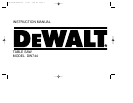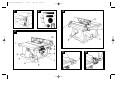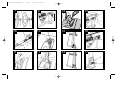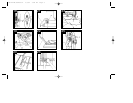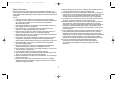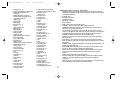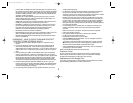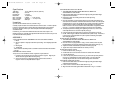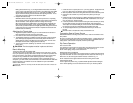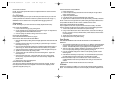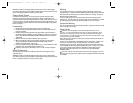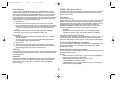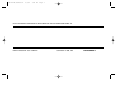
3
• IF YOU STALL OR JAM the saw blade in the workpiece, turn saw OFF, remove
the workpiece from the saw blade, and check to see if the saw blade is parallel to
the mitre gauge slots or grooves and if the splitter is in proper alignment with the
saw blade. If ripping at the time, check to see if the rip fence is parallel with the
saw blade. Readjust as indicated.
WARNING: Do not allow familiarity (gained from frequent use of your saw) to
replace following safety rules. Always remember that a careless fraction of a
second is sufficient to inflict severe injury.
• MAKE SURE your fingers do not contact the terminals of the power cord when
installing or removing the plug to or from the line power source.
• KICKBACKS - Kickbacks can cause serious injury. A kickback occurs when a
part of the workpiece binds between the saw blade and the rip fence, or other
fixed object, and rises from the table and is thrown toward the operator.
Kickbacks can be avoided by attention to the following conditions:
• NEVER leave the saw turned ON and unattended.
• NEVER attempt to remove gum or resin from a saw blade in motion. Ensure the
blade has completely stopped and the electrical power is turned OFF.
• NEVER insert wedges between the blade flange and the blade to form what is
known as a wobble saw.
KICKBACKS - HOW TO AVOID THEM AND PROTECT
YOURSELF FROM POSSIBLE INJURY.
a) Be certain that the saw blade is parallel to the rip fence. Adjust fence if not
parallel.
b) Do not rip by applying the feed force to the section of the workpiece that will
become the cut-off (free) piece. Feed force when ripping should always be
applied between the saw blade and the fence...use a push stick for short work, 6”
(152 mm) wide or less. For less than 2” (52 mm) wide, you must use a special
fixture.
c) Keep saw blade guard, splitter and anti-kickback teeth in place and operating
properly. Keep teeth sharp. If teeth are not operational, return your unit to the
nearest D
EWALT Service Centre for repair. The splitter must be in alignment with
the saw blade and the teeth must stop a kickback once it has started. Check
their action before ripping by pushing the wood under the anti-kickback teeth.
The teeth must prevent the wood from being pulled toward the front of the saw.
d) Plastic and composition (like hardboard) materials may be cut on your saw.
However, since these are usually quite hard and slippery, the anti-kickback teeth
may not stop a kickback. Therefore, be especially attentive to following proper
set up and cutting procedures for ripping.
e) Use saw blade guard and splitter for every operation for which it can be used,
including all through sawing.
• DO NOT leave a long board (or other workpiece) unsupported so the spring of
the board causes it to shift on the table. Provide proper support for the
workpiece, based on its size and the type of operation to be performed. Hold the
work firmly against the fence and down against the table surface.
• NEVER use a length stop on the free end of the workpiece when crosscutting.
Never hang onto or touch the free end of the workpiece when crosscutting, or a
free piece that is cut off when ripping while power is ON and/or the saw blade is
rotating. In short, the cut-off piece in any through sawing (cutting completely
through the workpiece) operation must never be confined – it must be allowed to
move away from saw blade.
• IF YOUR SAW makes an unfamiliar noise or if it vibrates excessively, cease
operating immediately until the source has been located and the problem
corrected.
• KEEP OUT of the line of saw blade. Stand to the side whenever possible.
• USE a push-stick when required.
• PAY particular attention to instructions on reducing risk of kickback.
• DO NOT perform any operation free hand.
• NEVER reach around, behind or over saw blade.
• USE RECOMMENDED ACCESSORIES. The use of improper accessories
may cause risk of personal injury.
CAUTION: Some wood contains preservatives such as copper chromium
arsenate (CCA) which can be toxic. When cutting these materials extra care
should be taken to avoid inhalation and minimise skin contact.
• USE A DUSTMASK and safety glasses when sawing. This saw is capable of
generating large amounts of sawdust.
SAVE THESE INSTRUCTIONS FOR FUTURE USE
Extension Cords
Use only extension cords that are approved by the country’s electrical authority.
Before using an extension cord, inspect it for loose or exposed wires, damaged
insulation and defective fittings. Replace the cord if necessary.
Replacement of the Supply Cord
If the supply cord is damaged, it must be replaced by the manufacturer or its service
agent or similarly qualified person in order to avoid a hazard.
DW744-XE/387486-01 5/1/02 3:44 PM Page 9



